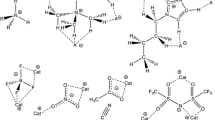Abstract
The lattice energies of a series of organic dihydrogenphosphate salts capable of second harmonic generation (SHG) have been calculated. These calculations, coupled with empirical data, indicate that a minimum of 20–25% of the lattice energy arises from hydrogen-bond interactions. Hydrogen bonding is shown to be a strong enough force to have a profound effect on the overall packing and crystal geometry of such ionic materials, and is thus an important factor to consider for crystal engineering.
Similar content being viewed by others
References
Chemla, D. S.; Zyss, J., Eds.Nonlinear Optical Properties of Organic Molecules and Crystals; Academic Press: New York, 1987; Vols. 1 and 2.
Williams, D. J., Ed.Nonlinear Optical Properties of Organic and Polymeric Materials, ACS Symp. Ser. 233; American Chemical Society: Washington, D.C., 1983.
Khanarian, G. Ed.Molecular and Polymeric Optoelectronic Materials: Fundamentals and Applications, SPIE 682; SPIE: San Diego, 1986.
Aakeröy, C. B.; Hitchcock, P. B.; Moyle, B. D.; Seddon, K. R.J. Chem. Soc., Chem. Commun.,1989, 1856.
Aakeröy, C. B.; Hitchcock, P. B.; Seddon, K. R. unpublished results.
Catlow, C. R. A.; Mackrodt, W. C., Eds.Computer-Simulation of Solids, Lecture Notes in Physics 166; Springer: Berlin, 1982.
Catlow, C. R. A.; Freeman, C. M.; Islam, M. S.; Jackson, R. A.; Leslie, M.; Tomlinson, S. M.Phil. Mag. A,1988,58, 123.
Seitz, F.Modern Theory of Solids, 1st ed.; McGraw-Hill: New York, 1940.
Lisker, E. J.; Cowlan, N.; Gilliot, L.Acta Crystallogr., Sect. B.,1979,35, 1033.
Lerbscher, J. A.; Trotter, J.Acta Crystallogr., Sect. B.,1976,32, 2671.
Jenkins, H. D. B.; Pratt, K. F.Adv. Inorg. Chem. Radiochem.,1979,22, 1.
Pullman, A.; Armbruster, A. M.Int. J. Quantum Chem. Symp.,1974,8S, 169.
Handbook of Chemistry and Physics, 66th ed.; CRC Press: Boca Raton, FL, 1985–86.
Meot-Ner (Mautner), M. InMolecular Structure and Energetics, Vol. 4 Liebman, J. F.; Greenberg, A., Eds.; VCH: New York, 1987; pp. 72–103.
Lehn, J.-M.Angew. Chem. Int. Ed. Engl.,1988,27, 89.
Etter, M. C.; Adsmond, D. A.J. Chem. Soc., Chem. Commun.,1990, 589.
Leslie, M.SERC Daresbury Lab. Kept. DL-SCI-TM31T, 1982.
Ewald, P. P.Ann. Physik,1921,64, 253.
Binkley, J. S.; Frisch, M. J.; Raghavachari, K.; DeFrees, D.-J.; Schlegel, H. B.; Whiteside, R. A.; Fluder, G.; Seeger, R.; Pople, J. A.GAUSSIAN 82, release A; Carnegie-Mellon University, 1983.
Author information
Authors and Affiliations
Rights and permissions
About this article
Cite this article
Aakeröy, C.B., Seddon, K.R. & Leslie, M. Hydrogen-bonding contributions to the lattice energy of salts for second harmonic generation. Struct Chem 3, 63–65 (1992). https://doi.org/10.1007/BF00671981
Received:
Accepted:
Issue Date:
DOI: https://doi.org/10.1007/BF00671981




